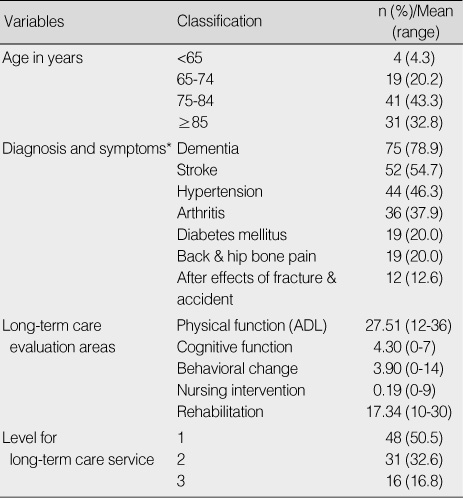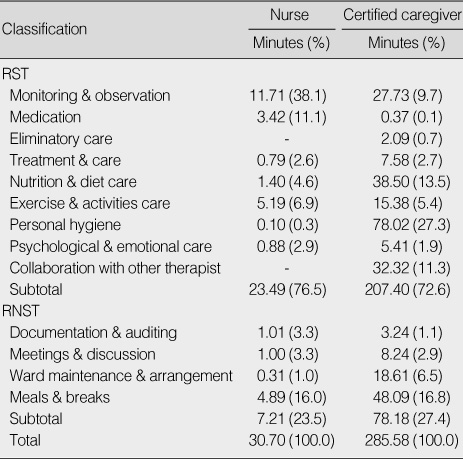Articles
- Page Path
- HOME > J Korean Acad Nurs > Volume 40(6); 2010 > Article
-
Original Article
- Relationship between Resource Utilization and Long-term Care Classification Level for Residents in Nursing Homes
- Min Kyung Lee, Eun-Kyung Kim
-
Journal of Korean Academy of Nursing 2010;40(6):903-912.
DOI: https://doi.org/10.4040/jkan.2010.40.6.903
Published online: December 31, 2010
1Nurse, Eulji University Hospital, Daejeon, Korea.
2Assistant Professor, Department of Nursing, Mokpo National University, Muan, Korea.
- Address reprint requests to: Kim, Eun-Kyung. Department of Nursing, Mokpo National University, 61 Dorim-ri, Cheonggye-myeon, Muan 534-729, Korea. Tel: 82-61-450-2672, Fax: 82-61-450-2679, eunkyung@mokpo.ac.kr
Copyright © 2010 Korean Society of Nursing Science
Abstract
-
Purpose
- This study was conducted to examine whether the level of classification for long-term care service under long-term care insurance reflects resource utilization level for residents in nursing homes.
-
Methods
- From 2 long-term care facilities, the researchers selected 95 participants and identified description and time of care services provided by nurses, certified caregivers, physical therapists and social workers during a 24-hr-period.
-
Results
- Resource utilization level was: 281.04 for level 1, 301.05 for level 2 and 270.87 for level 3. Resource utilization was not correlated with level. Differences in resource utilization within the same level were similar with the coefficient of variance, 22.7-27.1%. Physical function was the most influential factor on long-term care scores (r=.88, p<.001). The level for long-term care service did not reflect differences in resource utilization level of residents on long-term care insurance.
-
Conclusion
- The results of this study indicate that present grading for long-term care service needs to be reconsidered. Further study is needed to adjust the long-term care classification system to reflect the level of resource utilization for care recipients on the long-term care insurance.
- 1. Bjorkgren MA, Fries BE, Shugarman LR. Testing a RUG-III based case-mix system for home care. Canadian Journal on Aging. 2000;19:suppl 2. 106–125.
- 2. Campbell J, Ikegami N. Japan's radical reform of long-term care. Social Policy and Administration. 2003;37(1):21–34.Article
- 3. Choi BH, Shin HS, Hu SI, Sun WD, Byun YC, Kim SC, et al. Evaluation research of demonstration for long-term care insurance: Cost, standardized facilities' model & long-term care service, quality management part. 2007;Seoul, Korea Institute for Health and Social Affairs.
- 4. Choi JH, Han ST, Kang HC, Kim ES, Kim MK, Lee SG. Prediction and application of data mining using answer tree 3.0. 2002;Seoul, SPSS Academy.
- 5. Harrington C. Nursing facility staffing policy: A case studyfor political change. Policy, Politics, and Nursing Practice. 2001;2:117–127.ArticlePDF
- 6. Harrington C, Carrillo H, Blank BW. Nursing facilities, staffing, residents, and facility deficiencies, 2003 through 2008. 2009;Retrieved November 16, 2009. from http://www.nccnhr.org/node/227.
- 7. Im JG. A review on assessment and classification instrument in Korean long-term care system-focused on comparative analysis of foreign system-. Health and Social Welfare Review. 2005;25:175–220.
- 8. Jeong KH, Seok JE, SunWoo D, Kim CW, Lee TH, Lee TJ, et al. Development of evaluation and screening system and cost of long-term care insurance for elders. 2005;Seoul, Korea Institute for Health and Social Affairs.
- 9. Kang IO. Comparison of long-term care services assessment instrument among countries. Health Insurance & Policy. 2009;8:159–181.
- 10. Kang IO, Lee JS, Kwon JH, Han EJ, Lee YK. Development for relationship between assessment tools of long-term care insurance and evaluation indicators. 2008;Seoul, National Health Insurance Corporation.
- 11. Kim CH. The condition and problem of evaluation system in long-term care insurance. 2008;11;Paper presented at the international meeting of the Korean Gerontological Society, Seoul.
- 12. Kim CJ, Kim YS, Kang HY, Park JH, Sung MS, Woo YJ, et al. Development of home care quality indicators (HCQIs) at demonstration project of elderly care insurance program in Korea. Journal of the Korean Geriatrics Society. 2008;28:377–394.
- 13. Kim EK. Care time of elderly in long-term care facilities. Journal of Korean Academy of Nursing Administration. 2003;9:353–366.
- 14. Kim EK, Park HY, Kim CY. On the feasibility of a RUG-III based payment system for long term care facilities in Korea. Journal of Korean Academy of Nursing. 2004;34:278–289.ArticlePubMedPDF
- 15. Korean National Statistical Office. 2008 statistics of old aged. 2008;Daejeon, Author.
- 16. Kwon S. Population aging, medical expenditure and long-term care reform in Korea. Social Security Research. 2006;22(2):1–22.
- 17. Lee JY, Yoon JY, Kim JH, Song SH, Joo JS, Kim EK. Development of patient classification system in long-term care hospitals. Journal of Korean Academy of Nursing Administration. 2008;14:229–240.
- 18. Lee KO, Im ML. A study on the level of demand for nursing service for the old people resident in the nursing home. Nursing Science. 2002;14(2):45–56.
- 19. Lee MS. A study about older people long-term care insurance: Focus on Germany, Japan and Korea: Comparative analysis. 2007;Seoul, Han Yang University. Unpublished master's thesis.
- 20. Ministry of Health, Welfare and Family Affairs. A study on the development for long-term care insurance system. 2004;Seoul, Author.
- 21. Ministry of Health, Welfare and Family Affairs. 2009 the instruction of elderly welfare. 2009a;Seoul, Author.
- 22. Ministry of Health, Welfare and Family Affairs. Long-term care insurance after 1 year. 2009b;07 02 Retrieved June 29, 2009. from http://www.longtermcare.or.kr/portal/ny/jsp/p/d/03/nypd_publicDatalst_R.jsp?searchType=ALL&searchWord=&pageSize=&branch_id=&communityKey=B0010&bltBdCd=1102&act=VIEW&pageNum=1&boardId=50124.
- 23. National Health Insurance Corporation. Long-term care insurance. 2008;07 01 Retrieved August 1, 2009. from http://www.longtermcare.or.kr/portal/site/nydev/menuitem.6b1ad78dd7b58491cccdc3d584b310a0.
- 24. Park JY, Kwon JH, Lee JS, Kang IO, Lee YH, Kim DH. A study on the strategy for expansion of long-term care population and service. 2008;Seoul, National Health Insurance Corporation.
- 25. Rothgang H. Conrad H, Lutzeler R. Long-term care in Germany: Projections on public long-term care insurance financing. In: Aging and social policy: A German-Japanese comparison. 2002;Munchen, IUDICIUM. 251–273.
- 26. Schnelle JF, Simmons SF, Harrington C, Cadogan M, Garcia E, Bates-Jensen BM. Relationship of nursing home staffing to quality of care. Health Services Research. 2004;39:225–250.ArticlePubMedPMC
- 27. Seok JE. Unit cost of care services in long-term care insurance in Korea-its characteristics and evaluation-. Korean Journal of Social Welfare Studies. 2008;39:253–286.
- 28. Yoon JL. The condition and problem of evaluation system in long-term care insurance. 2008;Seoul, Paper presented at the international meeting of the Korean Gerontological Society.
- 29. Zhang X, Grabowski DC. Nursing home staffing and quality under the nursing home reform act. Gerontologist. 2004;44:13–23.ArticlePubMed
REFERENCES

Figure & Data
REFERENCES
Citations

- Comparison of resource utilization by physical function, cognitive function, and behavioral symptoms of residents in long-term care facilities: A cross-sectional study
Eun-Jeong Han, Seonhwa Lee, JungSuk Lee, Myonghwa Park
Journal of Korean Gerontological Nursing.2023; 25(4): 432. CrossRef - Comparison of Utilized Resource Volumes by Grade of Seniors in Long-Term Care Facilities
Eun-Jeong Han, Seonhwa Lee, Rahil Hwang
Journal of Korean Gerontological Nursing.2022; 24(1): 96. CrossRef - Research on Disability Grading Based on ICF Functional Framework: Empirical Evidence From Zhejiang Province, China
Huan Liu
Frontiers in Public Health.2021;[Epub] CrossRef - The effect of aerobic exercise based korean traditional dance on vascular health, muscle strength and balance in the elderly with dementia
Mi Yang Jeon, Chi Yang Yoon, Mi Jeong Jin, Dong Hyun Yi, Hyeon Cheol Jeong
The Journal of Korean Academy of Physical Therapy Science.2020; 27(3): 12. CrossRef - Incidence of hip fracture among long-term care insurance beneficiaries with dementia: comparison of home care and institutional care services
Juyeong Kim, Young Choi, Eun-Cheol Park
BMC Geriatrics.2019;[Epub] CrossRef - Does long‐term care insurance reduce the burden of medical costs? A retrospective elderly cohort study
Jae Woo Choi, Eun‐Cheol Park, Sang Gyu Lee, Sohee Park, Hwang‐Gun Ryu, Tae Hyun Kim
Geriatrics & Gerontology International.2018; 18(12): 1641. CrossRef - Factors Influencing Care Behavior of Certified Care Assistants for Older Adults with Dementia
Ji-yeon Kim, Sunghee H Tak
Journal of Korean Gerontological Nursing.2018; 20(3): 185. CrossRef - Demand and willing to pay for oral hygiene service in long-term care insurance of elderly
Han-Nah Kim, Gi-Yon Kim, Hie-Jin Noh, Nam-Hee Kim
Journal of Korean Academy of Oral Health.2018; 42(4): 204. CrossRef - Incidence of Pressure Ulcers During Home and Institutional Care Among Long-Term Care Insurance Beneficiaries With Dementia Using the Korean Elderly Cohort
Juyeong Kim, Young Choi, Jaeyong Shin, Suk-Yong Jang, Kyeong Hee Cho, Jin Young Nam, Eun-Cheol Park
Journal of the American Medical Directors Association.2017; 18(7): 638.e1. CrossRef - Factors Associated with the Changes in Activities of Daily Living in Older Adults with Stroke: A Comparison of Home Care and Institutional Care
Woon-Sook Jung, Eun-Shil Yim
Journal of Korean Academy of Community Health Nursing.2016; 27(4): 388. CrossRef - Cognitive Function, Behavioral Problems, and Physical Function in Long‐Term Care Insurance Beneficiaries with Dementia in South Korea: Comparison of Home Care and Institutional Care Services
Tae Wha Lee, Eunsil Yim, Eunhee Cho, Jane Chung
Journal of the American Geriatrics Society.2014; 62(8): 1467. CrossRef - Cognitive Function and Activity of Daily Living of Older Adults Using Long-term Care Service
Hyun-Sook Chang, Hung Sa Lee
Korean Journal of Health Policy and Administration.2012; 22(4): 522. CrossRef
General and Clinical Characteristics of Participants (N=95)
*The disease diagnosis or symptoms have a marked effect on current health status (multiple responses).
ADL=Activity of daily living.
Distribution of Long-term Care Time by Nurse and Certified Caregiver (N=95)
RST=Resident-specific time; RNST=Resident-non-specific time.
Comparison of Resource Utilization by Classification Level for Long-term Care Services (N=95)
Comparison of Resource Utilization by Classification Level for Long-term Care Services (N=95)
CV=Coefficient of variance.
Correlation Among the Measured Variables by Long-term Care Evaluation Area (N=95)
*The disease diagnosis or symptoms have a marked effect on current health status (multiple responses). ADL=Activity of daily living.
RST=Resident-specific time; RNST=Resident-non-specific time.
CV=Coefficient of variance.
 KSNS
KSNS
 E-SUBMISSION
E-SUBMISSION




 Cite
Cite

